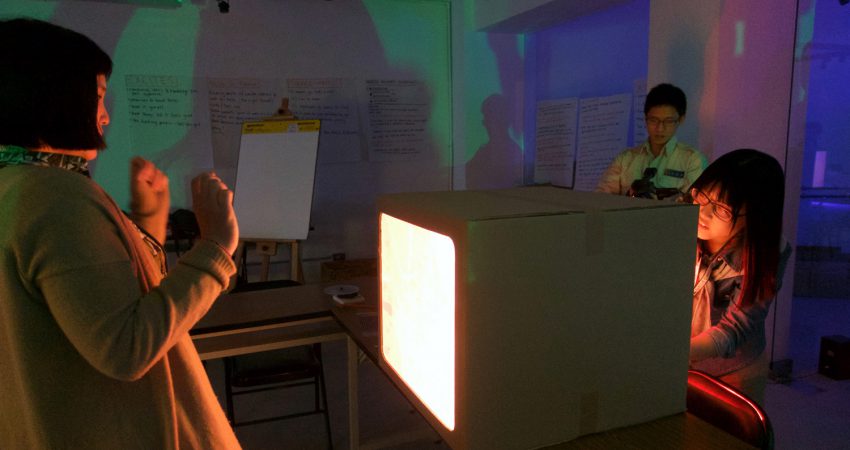
By Heather King - July 2013
PAPER CITATION
McGregor, D. (2012). Dramatising science learning: Findings from a pilot study to re-invigorate elementary science pedagogy for five- to seven-year olds. International Journal of Science Education, 34(8), 1145–1165.
The potential for teachers to enact imaginative approaches to science learning is not always realised. Rather, teachers tend to engage in safe but unexciting transmission of science knowledge. This study examined a professional development programme wherein primary teachers learned the skills and approaches of Dramatic Science. Dramatic Science “purposely places children in thought-provoking and stimulating situations where they need to apply scientific understanding to work out what to do or how to act” (p. 1147). The approach makes abstract notions more concrete and invites young children to immerse themselves in science. By engaging in this way, and by communicating and conveying ideas amongst themselves, children extend their thinking and advance their learning.
Theoretical Basis
The Dramatic Science approach builds on Piagetian notions of active constructivist learning in that children engage in collaborative discussions to plan enactments. They physically interpret ideas in an atmosphere that promotes reflection. The approach also embodies Vygotskian theory, in which learning is considered to occur in the spaces between people, so that it is facilitated by social interaction and, in kindergarten and elementary classrooms, in play. In addition, the dramatic technique of taking on roles to ask and answer questions and to interpret content promotes “exploratory talk,” which Mercer (1995) argues is effective for fostering learning.
The approach helps educators to address any misconceptions held by learners because the activities require children to express their thinking. The author explains that drama activities “provide contextual purpose and an opportunity to make thinking more conscious and explicit through translating cognitive activity into a physical tangible form” (p. 1161).
Research Design
The Dramatic Science professional development programme was developed and led by a creative team including a teacher educator, a local advisory teacher, and a drama educator. The pilot programme involved 20 teachers from 10 elementary schools in a largely suburban area in central England.
The professional development, conducted during six days in one academic year, explored eight basic teaching techniques suitable for children ages 5–7:
• On the Table: Children learn a technique for displaying and magnifying objects. • Spontaneous Role Play: Children are placed in various contexts and argue their view through their character. • Hot Seating: One child plays the expert who answers questions posed by the class. • Mind Movies: Given visual and auditory information places children in a different location or time, and they have to consider the consequences. • Miming Movement: Children act out what it might be like to have something happen. • Freeze Frame: Children pause mid-action to reflect on what is happening. • Modelling: Children mimic how something, such a machine, or even a physical process works. • Acting: Children take roles in mini-plays of historical events related to science.
To provide purpose and authenticity to the learning experiences, these techniques were contextualised within broad themes, including exploration, the Olympics, toys, and food.
The professional development and its effect on participating teachers were studied using quantitative and qualitative tools. The teachers completed reflective journals documenting their experiences and their attempts to employ the teaching techniques in their classrooms. They also completed questionnaires. The professional development sessions and some lessons were observed and video-recorded.
The analysis indicated that the teachers’ development occurred across six phases:
1. Becoming conversant and familiar with the pedagogical ideas and techniques being presented 2. Recognising instances of children’s incomplete understanding or misconceptions and identifying opportunities to respond appropriately 3. Experiencing revelation in their understanding of children’s ability and of the efficacy of the techniques 4. Succeeding despite the challenges of employing new approaches and engaging in unfamiliar practices 5. Becoming more confident and creative in employing the techniques 6. The finale: being able to imaginatively and innovatively—and regularly—apply drama approaches
Implications for Practice
The use of drama to engage audiences is not necessarily new to informal science educators. However, this study reminds us that the teachers with whom we work may not be confident in facilitating learning in this way.
In recent years, increasing attention has focused on the nature and value of inquiry approaches for science learning. However, some understanding of science content and concepts is necessary for full and effective engagement in inquiry; without highly skilled facilitation, young children may not benefit. Dramatic Science allows educators to see where problems are and to appreciate whether children really understand a concept or still have limited comprehension. It provides an approach for making the abstract tangible and is arguably a valuable addition to an ISE educator’s repertoire.
The description of the various stages in understanding and confidence as the teachers progressed through the professional development programme may also be useful in assessing and reflecting on other (non-drama-based) professional development. For example, to what extent do teachers reach Stage 6 following their engagement in PD and thus regularly employ their newly learned techniques?
References cited
Mercer, N. (1995). The guided construction of knowledge: Talk amongst teachers & learners. Clevedon: Multilingual matters.




